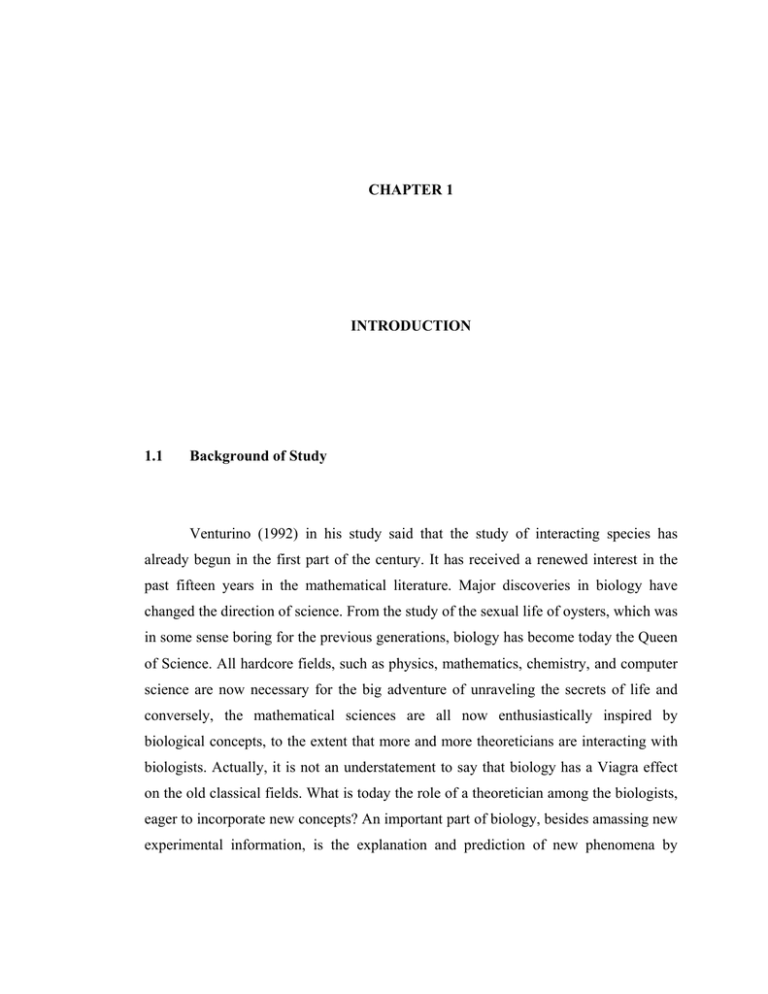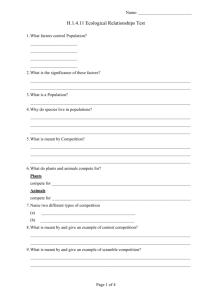Venturino (1992) in his study said that the study of... already begun in the first part of the century. It... CHAPTER 1
advertisement

CHAPTER 1 INTRODUCTION 1.1 Background of Study Venturino (1992) in his study said that the study of interacting species has already begun in the first part of the century. It has received a renewed interest in the past fifteen years in the mathematical literature. Major discoveries in biology have changed the direction of science. From the study of the sexual life of oysters, which was in some sense boring for the previous generations, biology has become today the Queen of Science. All hardcore fields, such as physics, mathematics, chemistry, and computer science are now necessary for the big adventure of unraveling the secrets of life and conversely, the mathematical sciences are all now enthusiastically inspired by biological concepts, to the extent that more and more theoreticians are interacting with biologists. Actually, it is not an understatement to say that biology has a Viagra effect on the old classical fields. What is today the role of a theoretician among the biologists, eager to incorporate new concepts? An important part of biology, besides amassing new experimental information, is the explanation and prediction of new phenomena by 2 applying the quantitative laws of physical chemistry, that is, by quantifying phenomena in mathematical terms, not by merely fitting curve with Numerical Recipes in Matlab. Theory is not a painting of the real but it gives the framework for quantitative computations, analysis and prediction. Data analysis is only small fraction of statistics. The putting together of the pieces of the puzzle of life begins with the understanding the life of a protein, a microstructure, a cell, a network, and finally, the life of a living organism. In order to explain how a pure theoretician, can contribute to the analysis of biological systems, let us review some selected open questions. Predation is one of the examples of interaction. Predation occurs when one animal (the predator) eats another living animal (the prey) to utilize the energy and nutrients from the body of the prey for growth, maintenance or reproduction. Predation is often distinguished from herbivory by requiring that the prey be an animal rather than a plant or other type of organism (bacteria). Population dynamics refers to changes in the sizes of populations of organisms through time, and predator-prey interactions may play an important role in explaining the population dynamics of many species. They are a type of antagonistic interaction, in which the population of one species (predators) has a negative effect on the population of a second (prey), while the second has a positive effect on the first. For population dynamics, predator-prey interactions are similar to other types of antagonistic interactions, such as pathogen-host and herbivore-plant interactions. Many insect predators that share the same prey species are also quite likely to kill and devour each other. This is called Intraguild Predation (IGP), since it is predation within the guild of predators. IGP is a composition of three species community consisting of resource, consumer and predator. IGP is a special case of omnivory, induces two major differences with traditional linear food chain models: the potential for the occurrence of two alternative stable equilibria at intermediate levels of resource productivity and the extinction of the consumer at high productivities. At low 3 productivities, the consumer dominates, while at intermediate productivities, the predator and the consumer can coexist. These theoretical results indicate that the conditions for stable food chains involving IGP cannot involve strong competition for the bottommost resources. Predator-prey interactions may have a large impact on the overall properties of a community. For example, most terrestrial communities are green; suggesting that predation on herbivores is great enough to stop them from consuming the majority of plant material. In contrast, the biomass of herbivorous zooplankton in many aquatic communities is greater than the biomass of the photosynthetic phytoplankton, suggesting that predation on zooplankton is not enough to keep these communities green. 1.2 Problem Statements Interaction between individuals and species in the real world are complex processes. Every living creature grows, reproduces and eventually dies. In order to survive, an individual uses its environment for food and protection to its own advantage. Population sizes of species are affected not only by ecological interactions such as competition, predation and parasitism, but also by the effects of infectious diseases. One host species can exclude another by means of a shared infectious disease. This model suggests that apparent competitive dominance can result if individuals of one species, as compared to individuals of other species, have a higher growth rate when uninfected, are less susceptible to becoming infected, or have a higher tolerance to the disease. The higher tolerance to disease of individuals of one species may result from their faster recovery, lower death rates or higher reproductive rates. For many diseases, long time behaviour of disease transmission is related to initial positions. If the initial value of infective numbers is large, which means we have a large invasion of a disease, the disease will be persistent. If the initial value of infective numbers is small, 4 which corresponds to a small invasion of a disease, the disease will be extinct. The study of such population ecology can help us understand the growth, extinctions and changes in distribution of populations and the underlying processes which determine these changes. 1.3 Objectives of Study The objectives of this study are: 1. To formulate a mathematical model of Intraguild Predation (IGP) population with infectious diseases. 2. To find the equilibrium points of the IGP model with disease. 3. To analyze the stability of the equilibrium points of IGP model with disease. 1.4 Scope of Study This study will be focused on unstructured IGP populations. For the purpose of this study, we shall only concentrate on two species population with an infectious disease for one species at one time. We only consider SI model and only one type of ways in which individual contract the disease which is mass action incidence. 5 1.5 Significant of Study The findings from this study will contribute towards an enhanced understanding of IGP among species and the effect of diseases on the dynamics of the population. The key result in this model is that the diseases must either die out in both species or remain endemic in both species.



